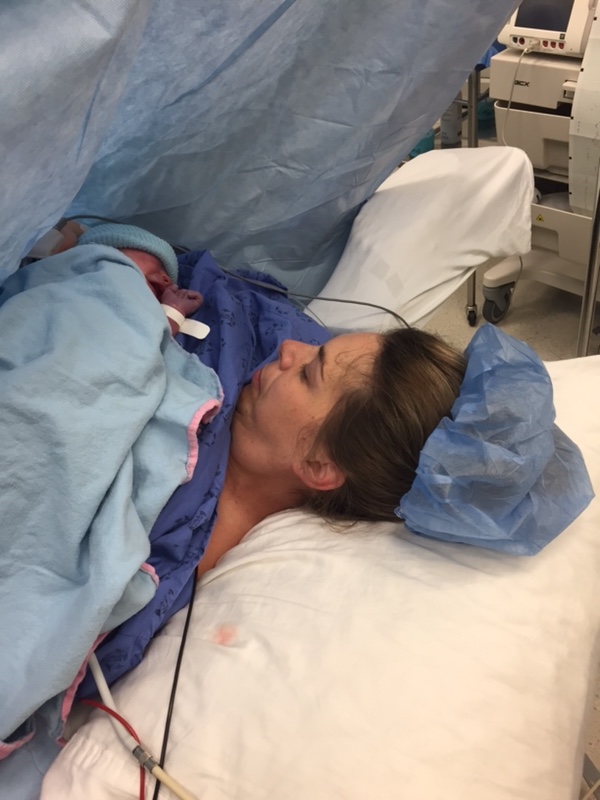I never thought I’d be sharing my personal journey following a c-section. But here I am, one year later. In the best physical shape of my life.
It’s been a year full of emotional and physical pain. Being left traumatized from the whole experience, making sense of a birth gone wrong leaves a lot of pieces being picked up.
It has also left me with a more of a go for it kind of attitude because it gave me the strength to trust in my body which is something I’ve never been able to do. In a sense, my c-section was what I needed. I never truly believed my body was strong. I treated it like a fragile crystal glass which could be broken if I pushed it too had. As a result, my self-confidence suffered.
Let me start from the beginning of the journey and how I wound in the best shape of my life.
It was 2017. My plan was to have a home birth. I had one with my daughter and was confident it was going to happen again. I was 36+5 days pregnant when my water broke — and oops, there went my plan!
In the hospital, care was transferred to the OB from my midwife because I was considered preterm. And the safest place for me to give birth was the hospital. Not to mention, my son was in the breech position and in my heart, I knew a c-section was going to be the way I welcomed him into this world. In other words, a c-section was the only option.

The recovery process was the most traumatic and painful part. Turns out, I had air trapped in my diaphragm which Percocets couldn’t even take care of. (Quick confession: being that much pain from trapped air was worse than labor itself.)
It took 4 weeks for the air bubble to escape. At 4 weeks, my newborn baby become colicky. After having my abdomen cut open to deliver him, there wasn’t a whole lot of strength. I needed to regain this strength fast.
Because of all I went through, I committed to rehab to gain strength in my core. I began rehabbing myself in my living room. As a trained pelvic health fitness professional, I was able to identify where I needed the work most. And after having a c-section, there was numbness around my incision making this process even more challenging.
The rehab itself started around 3 weeks postpartum, using a program I developed myself and used with my clients. Starting with breathing, alignment, Kegels, and light strength training, I began to increase my core strength, reducing my back pain. Which helped with carrying a colicky baby around for hours on end.
A c-section birth is majorly traumatic on the body, Typically, a surgery of this nature takes between 9-12 months to heal. What’s concerning, women aren’t given proper rehab or training guidance by their postpartum healthcare providers. Many of these women find themselves returning to high-impact training long before their body is ready.
This doesn’t mean you have to wait 9-12 months before you begin high-impact training. But it’s best to start with core and pelvic floor rehab as soon as possible in your postpartum period.
Where I Started?
The First 6-Weeks
In the first 6-weeks, I was feeling limited in my movement. But it was still important for me to move as much as possible. I’d take short walks down the block or laps around the house.
I also started working on diaphragmatic breathing which began the retraining process of the deep core (diaphragm, transverse abdominis, multifidus, and the pelvic floor).
How I Used Breathing To Train My Deep Core:
- I’d lay on my back in a neutral alignment with my feet flat on the floor
- As I’d inhale through my nose, I focused on bringing the air up into my ribcage
- On the exhale, I’d do say like I was blowing through a straw and gentilly kegel. Nothing too forceful.
- Repeat 3-5 times throughout the day.
At the 4 week mark, I added in light, strength training movements like glute bridges and seated or lying band pull aparts for added resistance. These movements also activate the core and pelvic floor naturally which help in the strengthening process.
6-weeks And Beyond
At my 6-week clearance, I was given the green light to return to exercise as there were no underlying health concerns relating to my c-section. Although the 6-week clearance plays a key role in postpartum recovery, many doctors, OB’s, and midwives don’t assess pelvic health. This is why I scheduled an appointment with a pelvic floor physical therapist to examine my pelvic floor and core function internally before increasing the intensity of my fitness training.
Having a c-section birth doesn’t mean you’re exempt from pelvic health symptoms.
Pelvic Health Symptoms include:
- Pelvic organ prolapse. This is where one or more of your pelvic organs bulge through your vagina.
- Stress and urge incontinence (or a mix of both)
- Urinary or fecal incontinence
- Back/hip pain or discomfort
- Straining when going to the bathroom
- Vaginal flatulence
- Pelvic pain or discomfort in the pubic symphysis or the pelvic floor
- Uncontrollable gas and vaginal flatulence
My c-section scar was also a factor. It was numb and there wasn’t much movement. My pelvic floor physical therapist recommended I continue with scar massage.
After I received clearance from my doctor and pelvic floor physical therapist, I added in strength training. With that being said, I started with light to moderate resistance and worked up to something more challenging as my strength progressed.

I could only manage 10-15 minute workouts at a time. With the demands of a new baby and two other children, there wasn’t much time or energy to do anything more.
In the beginning, I avoided movements like:
- Crunches, sit-ups, leg raises, and front planks
- Running, jumping, step-ups
- Heavy overhead presses like push presses, thrusters, and snatches.
- Heavily weighted movement
As my strength increased, I experimented with these movements to see how they felt on my scar and pelvic floor. If there was pulling and tugging around my scar or if anything felt off in my pelvic floor, I took at as feedback that my body wasn’t ready and made modifications. If the modifications didn’t help, I’d omit them and try again a few weeks later.
Your body is resilient and you will get back to high-impact training in good time. But you need to build your body’s resilience step by step. If at any point you don’t feel good during your training, it’s ok to scale back and try again in a couple weeks. There is no shame in giving your body a break if it needs one.
Giving your body the tools to heal well after a c-section will help you return to your desired level of fitness, minimizing complications along the way. This may take a little extra patience on your part, but remember, having a c-section is a significant event body (and life) event.

